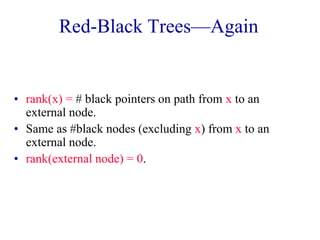
Red black 2
- 1. Red-Black Trees—Again • rank(x) = # black pointers on path from x to an external node. • Same as #black nodes (excluding x) from x to an external node. • rank(external node) = 0.
- 2. An Example 3 10 2 2 7 40 1 3 1 8 2 30 1 45 1 1 1 35 1 60 1 1 5 20 0 0 0 1 25 0 0 0 0 0 0 0 0 0 0 0
- 3. Properties Of rank(x) • rank(x) = 0 for x an external node. • rank(x) = 1 for x parent of external node. • p(x) exists => rank(x) <= rank(p(x)) <= rank(x) + 1. • g(x) exists => rank(x) < rank(g(x)).
- 4. Red-Black Tree A binary search tree is a red-black tree iff integer ranks can be assigned to its nodes so as to satisfy the stated 4 properties of rank.
- 5. Relationship Between rank() And Color • (p(x),x) is a red pointer iff rank(x) = rank(p(x)). • (p(x),x) is a black pointer iff rank(x) = rank(p(x)) – 1. • Red node iff pointer from parent is red. • Root is black. • Other nodes are black iff pointer from parent is black. • Given rank(root) and node/pointer colors, remaining ranks may be computed on way down.
- 6. rank(root) • Height <= 2 * rank(root). • No external nodes at levels 1, 2, …, rank(root). So, #nodes >= 1 <= i <= rank(root) 2i -1 = 2 rank(root) – 1. So, rank(root) <= log2(n+1). • So, height(root) <= 2log2(n+1).
- 7. Join(S,m,B) • Input Dictionary S of pairs with small keys. Dictionary B of pairs with big keys. An additional pair m. All keys in S are smaller than m.key. All keys in B are bigger than m.key. • Output A dictionary that contains all pairs in S and B plus the pair m. Dictionaries S and B may be destroyed.
- 8. Join Binary Search Trees m S B • O(1) time.
- 9. Join Red-black Trees • When rank(S) = rank(B), use binary search tree method. m S B • rank(root) = rank(S) + 1 = rank(B) + 1.
- 10. rank(S) > rank(B) • Follow right child pointers from root of S to first node x whose rank equals rank(B). p(x) p(x) m S x x B a b a b
- 11. rank(S) > rank(B) • If there are now 2 consecutive red pointers/nodes, perform bottom-up rebalancing beginning at m. • O(rank(S) – rank(B)). p(x) p(x) m S x x B a b a b
- 12. rank(S) < rank(B) • Follow left child pointers from root of B to first node x whose rank equals rank(B). • Similar to case when rank(S) > rank(B).
- 13. Split(k) • Inverse of join. • Obtain S … dictionary of pairs with key < k. B … dictionary of pairs with key > k. m … pair with key = k (if present).
- 14. Split A Binary Search Tree A S B a B C b c D E d e m f g
- 15. Split A Binary Search Tree S B B A C b a c D E d e m f g
- 16. Split A Binary Search Tree S B A B C a b c D E d e m f g
- 17. Split A Binary Search Tree S B A B a C b D c E d e m f g
- 18. Split A Binary Search Tree S B A B a C D b c d E e m f g
- 19. Split A Binary Search Tree S B A B a C D b c E d e m f g
- 20. Split A Binary Search Tree S B A B a C D b c E g d e f m
- 21. Split A Red-Black Tree • Previous strategy does not split a red-black tree into two red-black trees. • Must do a search for m followed by a traceback to the root. • During the traceback use the join operation to construct S and B.
- 22. Split A Red-Black Tree A S=f B=g a B C b c D E d e m f g
- 23. Split A Red-Black Tree A S=f B=g a B C b c D E d e
- 24. Split A Red-Black Tree A S=f B=g a B S = join(e, E, S) C b c D E d e
- 25. Split A Red-Black Tree A S=f B =g a B S = join(e, E, S) C b B = join(B, D, d) c D d
- 26. Split A Red-Black Tree A S=f B =g a B S = join(e, E, S) C b B = join(B, D, d) c S = join(c, C, S)
- 27. Split A Red-Black Tree A S=f B =g a B S = join(e, E, S) b B = join(B, D, d) S = join(c, C, S) B = join(B, B, b)
- 28. Split A Red-Black Tree A S=f B =g a S = join(e, E, S) B = join(B, D, d) S = join(c, C, S) B = join(B, B, b) S = join(a, A, S)
- 29. Complexity Of Split • O(log n) • See text.